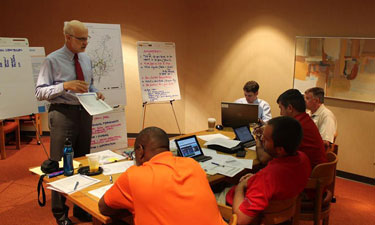 The 2014 NRPA Congress will feature a number of exciting speakers throughout the three-day event, including those slated to present during our new Glass Room Sessions. One such individual is David Barth, a planner, facilitator and designer with more than three decades of experience examining and reimagining public spaces. Barth’s credentials are many: He obtained a bachelor’s degree in landscape architecture at the University of Florida, achieved his master’s in organizational leadership from Palm Beach Atlantic University and is currently a Ph.D. candidate at the University of Florida College of Design, Construction and Planning. He’s also a Certified Park and Recreation Professional (CPRP) and a member of the American Society of Landscape Architects (ASLA) and the American Institute of Certified Planners (AICP). Barth will kick off the Glass Room Sessions with a discussion titled, “Creating High-Performance Park and Recreation Systems,” focusing on how park and recreation departments have a unique opportunity to become “more essential” by creating systems that make innovative contributions to their communities.
The 2014 NRPA Congress will feature a number of exciting speakers throughout the three-day event, including those slated to present during our new Glass Room Sessions. One such individual is David Barth, a planner, facilitator and designer with more than three decades of experience examining and reimagining public spaces. Barth’s credentials are many: He obtained a bachelor’s degree in landscape architecture at the University of Florida, achieved his master’s in organizational leadership from Palm Beach Atlantic University and is currently a Ph.D. candidate at the University of Florida College of Design, Construction and Planning. He’s also a Certified Park and Recreation Professional (CPRP) and a member of the American Society of Landscape Architects (ASLA) and the American Institute of Certified Planners (AICP). Barth will kick off the Glass Room Sessions with a discussion titled, “Creating High-Performance Park and Recreation Systems,” focusing on how park and recreation departments have a unique opportunity to become “more essential” by creating systems that make innovative contributions to their communities.
“I want to help communities harness the power of their park and recreation systems to become more resilient and sustainable,” says Barth, owner/operator of his new firm, David L. Barth LLC. Prior to establishing his own business, Barth served as a principal with Glatting Jackson/AECOM, where he worked on dozens of planning and consultation projects and honed his specializations in park and recreation planning, facilitation and design. All that experience has crafted his current vision of cities as spaces replete with benefits for the citizenry that are simply waiting to be harnessed. “Cities should be thinking about how they can generate the most benefits through the planning, design and/or management of their public realm,” Barth says. “Every element of the public realm — as much as 50 percent of a city’s land mass — has the potential to generate multiple benefits.”
Barth cites New York City’s High Line project as a great example of holistic design for maximum usage, saying, “[The High Line] has spurred redevelopment of the west side of the Chelsea area of Manhattan and serves as a social gathering space and a performance venue for local residents and tourists. It also reduces stormwater runoff, mediates the heat-island effect created by hard/reflective city surfaces, and creates shade, oxygen and habitat for insects and birds.” His current research on this and other projects he identifies as “High-Performance Public Spaces©” begins to scratch the surface of the multiple advantages of designing and placemaking with environmental stability, economic prosperity and alleviation of social problems in mind. Those include many of the 19 communitywide benefits that could potentially be delivered by the public realm, including parks, originally identified by Texas A&M Professor John Crompton. Those include protecting drinking water, attracting tourists, cleaning air, cultural and historic preservation, facilitating healthy lifestyles, enhancing real estate values and still others.
With the establishment of his firm, Barth hopes to disseminate the idea of smart growth and High-Performance Public Spaces© to as many municipalities as possible. An important part of that mission is advancing parks and recreation, and the professionals in that industry, as valuable contributors to creating viable, workable and valuable public spaces. “In addition to their traditional role in providing park and recreation services, park and recreation professionals have a unique opportunity to provide leadership in community sustainability and resiliency,” Barth says. “Many park and recreation departments control or influence as much as 50 percent of a community’s land mass, giving them the opportunity to plan, design and manage their public spaces to generate economic, social and environmental benefits.”
Another key to Barth’s planning and development mission is communicating the importance of conducting a comprehensive needs assessment of any public realm or parks plan, backed by “statistically valid quantitative techniques, including random mail/telephone surveys and GIS-based level-of-service analysis of park acreage, facilities, programs, access and quality,” he says. “[David L. Barth LLC] also uses NRPA’s PRORAGIS™ database to benchmark community park and recreation systems against other similar communities.”
October 14, Barth will discuss these ideas in depth, plus some of the roadblocks he sees that might impact the widespread adoption of smart growth and High-Performance Public Spaces©, as well as preservation and inclusion of parks in development plans. “Creating High-Performance Park and Recreation Systems” will take place from 11–11:45 a.m. in the impressive glass room space located on the exhibit hall floor. The six sessions planned there are intended to attract directors and upper-level professionals who want to discuss cutting-edge issues and topics with their peers and learn how others are dealing with similar challenges they are facing. No CEUs will be offered and session attendance will be purposely limited to 50 and will be on a first-come, first-served basis.
Samantha Bartram is the Associate Editor of Parks & Recreation Magazine.

